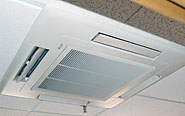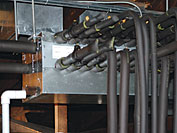
In this case, there were constant complaints from the guests about the temperature being either too hot or too cold. According to volunteers at the house, the air conditioning system was impossible to regulate. The RMH board had to step in.
The House Operations Committee searched for an air conditioning solution for 18 months. Their goal was to find a system that would deliver innovation in four vital areas: individual room controls, energy efficiency, cost savings, and improved IAQ. A detailed HVAC study was commissioned from a local HVAC company, but the RMH board found it to be insufficient. Now what?
SEEK AND YOU SHALL FIND
Logical answers finally arrived from EMCOR Service/Tucker Mechanical (Meriden, Conn.), a subsidiary of EMCOR Group (Norwalk, Conn.) An RMH board member, on the board of nearby prep school Hamden Hall, had been introduced to a new technology called City Multi® Variable Refrigerant Flow Zoning (VRFZ) system from the HVAC division of Mitsubishi Electric (Suwanee, Ga.). This board member asked Tucker's field service coordinator, Dave Hamilton, to investigate.Hamilton discovered that the VRFZ systems are designed to take advantage of inverter technology by varying the compressor speed of the outdoor unit to meet the changing load requirements in the indoor zones. According to the manufacturer, its VRFZ systems are designed to offer maximum individual comfort and energy savings because only the zones that need air conditioning or heating receive it. Each zone of the system has its own indoor unit or group of indoor units designed, as the manufacturer put it, "to precisely control the indoor temperature while operating at the most optimum energy usage."
Hamilton, a 33-year industry veteran, had been thinking of recommending a competitive system for RMH, but was struck by this system's ability to fulfill each one of the HVAC goals established by the operations committee. He especially liked the City Multi Controls Network (CMCN), which is designed to allow individual control of each indoor unit from a central location or inside each zone. In Hamilton's eyes, this was critical because of the medical needs of each occupant, as well as the diverse environments and climates they were accustomed to from all over the world.
Hamilton also liked the fact that this was a modular system, easy to install in an historic home, and that Mitsubishi Electric's solution utilizes VRFZ technology, which would provide simultaneous cooling and heating from one bedroom to the next. Because of CMCN, the outdoor units are engaged only when called upon, providing effective energy usage and cost efficiencies for RMH.

HOW IT WORKS
According to the manufacturer, its VRFZ R2-Series is made up of an outdoor unit, branch circuit controller (BC controller), indoor air handlers, and local zone controllers. A centralized control is designed to provide operational control for many City Multi systems for up to 50 zones. To simultaneously cool and heat, the BC controller acts as the heart of the system, it said, managing refrigerant gas and liquid and directing it to and from the air handlers calling for cooling or heating.Essentially, the system recovers heat energy from one space and sends it to another, said the manufacturer. This innovation results, it said, in virtually no energy wasted by being expelled outdoors when 50 percent of indoor units are heating and 50 percent are cooling. This special function results in optimum energy usage, said the company.
The R2-Series outdoor unit uses inverter-driven compressor VRFZ technology, designed to provide, as the company put it, "highly responsive cooling and heating performance." By responding to indoor and outdoor temperature fluctuations, Hamilton said the system varies power consumption by adjusting the compressor speed to optimize energy usage.
The company said electronic expansion valves control the variable-capacity indoor units. These valves, said the company, are designed to allow "only the precise amount of refrigerant needed to condition the space into the air handler."
Another plus, in Hamilton's estimation, is the fact this system offers a variety of ductless or ducted air handlers, such as ceiling-recessed, ceiling-concealed, floor-standing exposed and concealed, and wall-mounted models. In this system, one can mix and match the air handlers to support the needs of each unique zone to meet the design criteria of an entire building.
"I could see that this heat recovery system was so superior," said Hamilton, "that it would qualify for energy-efficient rebates from New Haven's electric utility provider United Illuminating, giving back much-needed dollars to the RMH nonprofit charity."

PROVES SUCCESSFUL
After reviewing its pluses and minuses, Hamilton recommended the purchase of the City Multi building comfort solution to the board in the fall of 2004. He then journeyed to Atlanta for intense hands-on training of the system. Actual work began in the winter of 2004-05. The two R-2 Series outdoor units were installed on the mansion's roof because of limited space on the ground, and, because the condensing units from the old system had worked well there.There was an open attic and easy access to the bedrooms on the third (top) floor. Pipes were then dropped down a chase wall containing the sprinkler system to a drop ceiling on the second floor. With the exception of a single wall-mounted unit in a tiny bedroom on the second floor, Hamilton specified the one-way ceiling-recessed cassette air-handler units, and the four-way ceiling-recessed cassette air-handler units for each bedroom "because of the gravity feed of the condensation down the existing drain lines to the main drain in the basement." The nine ceiling-recessed units were needed for their deflection due to heavier solar gain in nine of the bedrooms, said Hamilton.
EMCOR Service finished the RMH installation in time for last year's tremendously hot and humid summer. If there is another hot summer in New Haven this year, RMH is prepared.
"The installation went off without a hitch," said Hamilton. "It was very straightforward and easy on the 132-year-old mansion. This system is great for historic buildings, but the thing that really impressed me was the quiet. When I first hit the switch, I was stunned by the silence. In all my 33 years, I have never installed a system that runs so quietly."
And, yes, that is another plus for the system.
Publication date: 05/29/2006

Report Abusive Comment